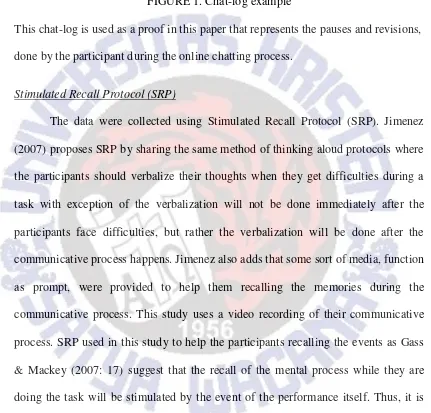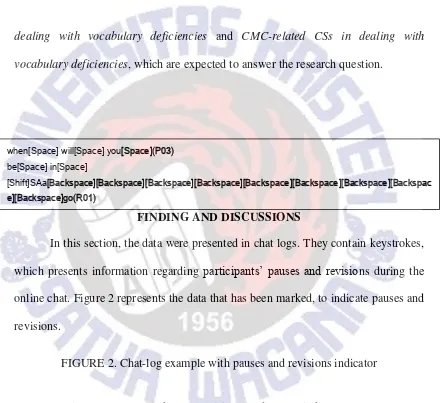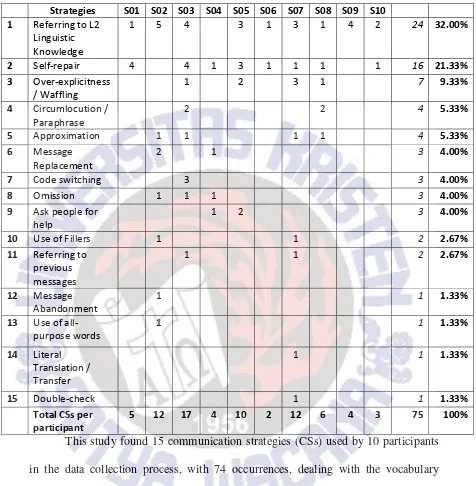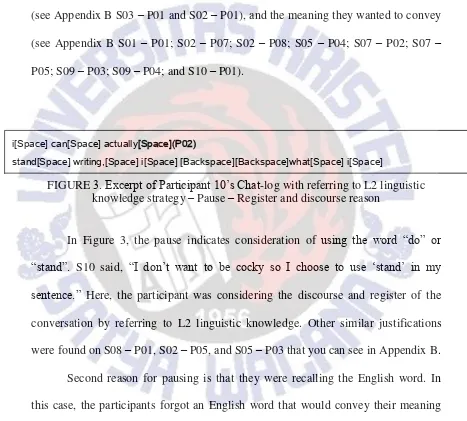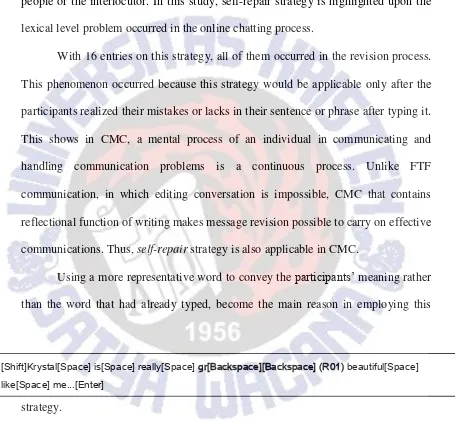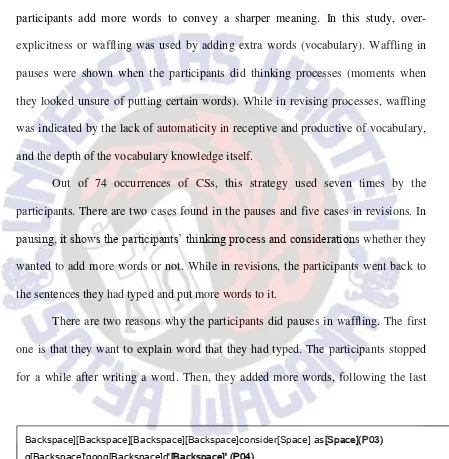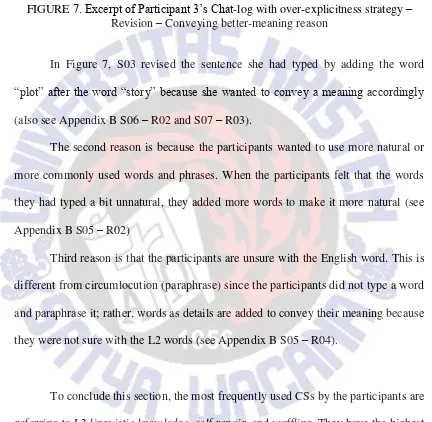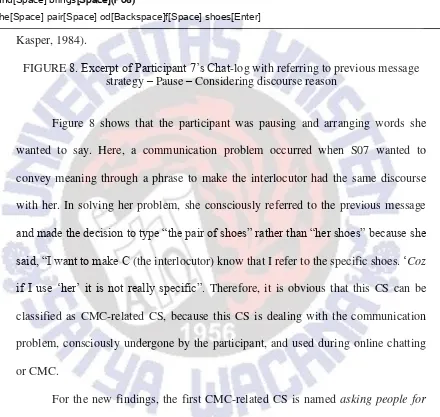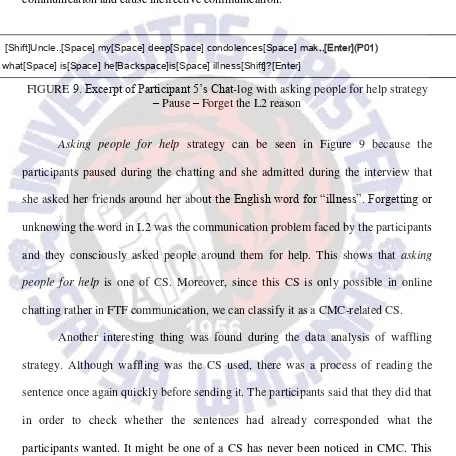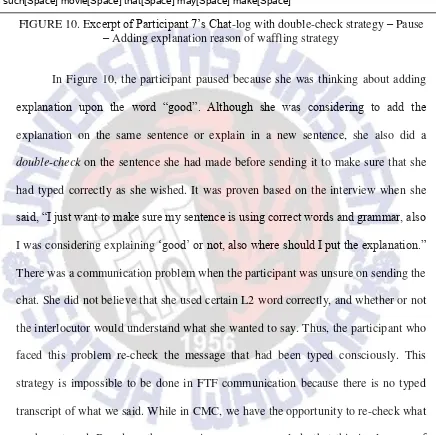THE USE OF COMMUNICATION STRATEGIES DURING
ONLINE CHATTING BY INDONESIAN EFL LEARNERS IN
DEALING WITH VOCABULARY DEFICIENCIES
THESIS
Submitted in Partial Fulfillment of the Requirements for the Degree of
Sarjana Pendidikan
Hezky Charisma Budiono 112011010
ENGLISH LANGUAGE EDUCATION PROGRAM
FACULTY OF LANGUAGE AND LITERATURE
SATYA WACANA CHRISTIAN UNIVERSITY
SALATIGA
THE USE OF COMMUNICATION STRATEGIES DURING
ONLINE CHATTING BY INDONESIAN EFL LEARNERS IN
DEALING WITH VOCABULARY DEFICIENCIES
THESIS
Submitted in Partial Fulfillment of the Requirements for the Degree of
Sarjana Pendidikan
Hezky Charisma Budiono 112011010
ENGLISH LANGUAGE EDUCATION PROGRAM
FACULTY OF LANGUAGE AND LITERATURE
SATYA WACANA CHRISTIAN UNIVERSITY
SALATIGA
THE USE OF COMMUNICATION STRATEGIES DURING
ONLINE CHATTING BY INDONESIAN EFL LEARNERS IN
DEALING WITH VOCABULARY DEFICIENCIES
THESIS
Submitted in Partial Fulfillment of the Requirements for the Degree of
Sarjana Pendidikan
Hezky Charisma Budiono 112011010
Approved by:
Dian Toar Y. G. Sumakul, M. A. Yustina Priska Kisnanto, M. Hum.
PUBLICATION AGREEMENT DECLARATION
As a member of the (SWCU) Satya Wacana Christian University academic community, I verify that:
Name : Hezky Charisma Budiono Student ID Number : 112011010
Study Program : English Department
Faculty : Faculty of Language and Literature Kind of Work : Undergraduate Thesis
In developing my knowledge, I agree to provide SWCU with a non-exclusive royalty free right for my intellectual property and the contents therein entitled:
THE USE OF COMMUNICATION STRATEGIES DURING ONLINE CHATTING BY INDONESIAN EFL LEARNERS IN DEALING WITH
VOCABULARY DEFICIENCIES
along with any pertinent equipment.
With this non-exclusive royalty free right, SWCU maintains the right to copy, reproduce, print, publish, post, display, incorporate, store in or scan into a retrieval system or database, transmit, broadcast, barter or sell my intellectual property, in whole or in part without my express written permission, as long as my name is still included as the writer.
This declaration is made according to the best of my knowledge. Made in : Salatiga
Date : ________________ Verified by signee,
Hezky Charisma Budiono Approved by
Thesis Supervisor Thesis Examiner
Copyright Statement
This thesis contains no such material as has been submitted for examination in any course or accepted for the fulfillment of any degree or diploma in any university. To the best of my knowledge and my belief, this contains no material previously published or written by any other person except where due reference is made in the text.
Copyright@ 2015. Hezky Charisma Budiono and Dian Toar Y. G. Sumakul, M.A
All rights reserved. No part of this thesis may be reproduced by any means without the permission of at least one of the copyright owners or the English Department, Faculty of Language and Literature, Satya Wacana Christian University, Salatiga.
Table of Content
Approval Page ... ii
Publication Agreement Declaration ... iii
Copyright Statement ... iv
Table of Content ... v
List Of Figures ... vi
Introduction ... 1
Literature Review ... 4
The Study ... 7
Findings and Discussions ... 11
Conclusion ... 25
Acknowledgment ... 27
References ... 28
Appendix A (Dornyei and Scott’s CSs Taxonomy) ... 30
List of Figures FIGURE 1. Chat-log example
FIGURE 2. Chat-log example with pauses and revisions indicator
FIGURE 3. Excerpt of Participant 10’s Chat-log with referring to L2 linguistic knowledge strategy – Pause – Register and discourse reason
FIGURE 4. Excerpt of Participant 7’s Chat-log with referring to L2 linguistic knowledge strategy – Revision – Unnatural language reason
FIGURE 5. Excerpt of Participant 1’s Chat-log with self-repair strategy – Revision – More representative words reason
FIGURE 6. Excerpt of Participant 7’s Chat-log with over-explicitness strategy – Pause – Considering explaining reason
FIGURE 7. Excerpt of Participant 3’s Chat-log with over-explicitness strategy – Revision – Conveying better-meaning reason
FIGURE 8. Excerpt of Participant 7’s Chat-log with referring to previous message strategy – Pause – Considering discourse reason
FIGURE 9. Excerpt of Participant 5’s Chat-log with asking people for help strategy
– Pause – Forget the L2 reason
FIGURE 10. Excerpt of Participant 7’s Chat-log with double-check strategy – Pause
THE USE OF COMMUNICATION STRATEGIES DURING
ONLINE CHATTING BY INDONESIAN EFL LEARNERS IN
DEALING WITH VOCABULARY DEFICIENCIES
Hezky Charisma Budiono 112011010
Satya Wacana Christian University, Salatiga Abstract
Computer Mediated Communication (CMC) becomes an effective communication in globalized era, although it also has some communication problems just like in face-to-face (FTF) communication. In order to deal with it, EFL learners who use English as L2 should have communication strategies. This study aimed to find out the communication strategies (CSs) employed by the EFL learners, Faculty of Language and Literature, Satya Wacana Christian University, Salatiga, Indonesia, to cope with the vocabulary deficiencies as the communication problem faced during online chatting. Nature of CSs, CMC, and the vocabulary dimensions become the theoretical framework of this study. Once the participants did an online chat and recorded, stimulated recall protocol (SRP) followed the data collection process using a semi-structured interview. FTF’s CSs taxonomy and CMC-related CSs upon grammatical level difficulties are used to analyze the data. Out of 15 CSs employed, two new CSs are proposed in this study. CSs in dealing with vocabulary problems that exclusively occurred in CMC will also be discussed in this paper. The finding may provide insight for teachers and EFL learners on how to overcome vocabulary difficulties while communicating through online chatting and maintain an effective communication.
Keywords: communication strategies, computer-mediated communication, vocabulary deficiencies, stimulated recall protocol
INTRODUCTION
time. However, since CMC participants can come from any parts of the world, the languages used are also varied. Thus, English become a lingua franca in CMC. However, the English language competencies among users may differ. Hence, it may lead to communication problems that are caused by linguistic gap, such as grammar incomprehension and vocabulary deficiency.
This study highlights vocabulary deficiencies, since it could be a major problem for L2 learners. Lessard-Clouston (2013) defines vocabulary as:
…the words of language, including single item or phrases or chunks or several words which co[n]vey a particular meaning, the way individual words do. Vocabulary addresses single lexical items – words with specific meaning(s) – but it also includes lexical phrases or chunks. (p. 2)
From the definition above, we can conclude that vocabulary deficiency is a condition when an individual meets a communication gap, in which an individual cannot convey meaning and express thoughts into words. Consequently, an effective communication (i.e. the achieved understanding upon the exchange of messages between communicator and interlocutor) might not be achieved.
In order to achieve and maintain an effective communication, EFL learners who face communication problems will try to find a way out during the communication process. This attempt is called communication strategies (CSs). In this study, CSs that are used during the online chatting are called as CMC-related CSs.
focused on product-based analysis (e.g. reflective journals), which did not reflect the psychological process of communication. Moreover, it did not focus on vocabulary deficiencies as the communication gap during personal online chatting; rather, it focused on inadequateness of English command in an Online Discussion (OLD) and strategic completion of a task-based CMC.
Therefore, this study aims to identify the CSs used to deal with the vocabulary deficiencies during personal online chatting, based on process-based approach, within the scope of EFL students from Faculty of Language and Literature in Satya Wacana Christian University, Salatiga. Later in the data analysis process, this study uses Dornyei and Scott’s (1997) CSs taxonomy and Sumakul’s (2011) CMC-related CSs to figure out CSs used by the participants during online chatting.
LITERATURE REVIEW Vocabulary Deficiencies
Deficiencies can be defined as the existing gap between ‘what a person have
in mind’ and their current ‘linguistic competence’ (Moattarian & Tahririan, 2013:
21). In addition, Rashidi and Koshravi (2010) based on Qian & Schedl (2004:30) suggest that vocabulary actually have four dimensions of knowledge; they are vocabulary size (number of words that learners understand the meaning), depth of vocabulary knowledge (lexical characteristics including register), lexical organization (storage, connection and representation of words in mental state of a learner), and automaticity of receptive and productive knowledge (fundamental process such as phonological and orthographic encoding and decoding, accessing mental-lexicon’s structure and semantic features, lexical-semantic integration and representation, and morphological parsing and composing).
Thus, vocabulary deficiency can be defined as a communication problem when the process of delivering ideas is unsuccessful due to a lack of comprehension on four vocabulary knowledge dimensions (e.g. do not know the English word, forget certain English word, and do not know whether it is appropriate to use under certain circumstances or not).
Communication Strategies (CSs)
Tarrone (1976: 78) provided the first definition of CSs as “a systematic
attempt by the learner to express or decode meaning in target language,” which
overcome the gap. In 1980, Tarrone reformulated her definition because she believed that interaction between communicator and interlocutor should be considered as well. She coined that the definition of CSs is a collaboration of two people’s (communicator and interlocutor) effort to have agreement on one meaning during the communication (Tarrone, 1980: 419). So far, we can reckon that the CSs focused on the product-based approach in FTF communication.
As a strategic attempt, CSs should involve psychological process when an individual think and formulate plans in their mind before executing the message. Consequently, CSs also can be seen from proses-based approach. Færch and Kasper (1980:81) believed CSs as “potentially conscious plans for solving what to an individual presents itself as a problem in reaching a particular communicative goal.” Hence, process based-approach in CS is indicated by cognitive process. This belief is also supported by Bialystok & Kellerman (1987) who suggested two main strategies
involving cognitive process, ‘conceptual’ and ‘linguistic/code’ archistrategy. This
cognitive process becomes an interest in this study since it reveals the psychological process of EFL learners in using a certain CS.
code switching used in his/her daily communication), those actions would not classified as CSs.
Computer Mediated Communication (CMC)
Turnbull (2010) suggests that in this era, the internet shifts face-to-face communication into Computer Mediated Communication (CMC). It used to take form of e-mail (Adler et al., 2009), which in nowadays popular CMC through text messages, applications of social networking and instant messenger. These forms give more flexibility in communicating with everybody everywhere (Lenhart, Madden, Cacgill, and Smith, 2007). CMC, which takes place in real-time situation, allows the
users to “negotiate meaning by modifying their written language” (Lee, 2002: 17).
Thus, CMC is mostly text-based. CMC in this paper will focus on online chat that is a form of synchronous (real-time) CMC, using Web 2.0 applications – Facebook Messenger. In real-time communication, the people involved should maintain he communication ongoing just as in FTF communication.
Since these two functions cannot occur in the same time but serve different purposes, synchronous CMC become the bridge that makes writing more interactive and open the possibility to edit, check, and store the message in computer. Thus, the nature of synchronous CMC combines the speaking features in the writing mode.
CSs in dealing with Vocabulary Deficiency in CMC
Two CMC-related CSs are used as theoretical framework in data analysis. First is Dornyei and Scott’s (1997) FTF CSs taxonomy (see in Appendix A). Despite the fact that it deals with FTF communication problems, this study tries to apply it in CMC that has different environment and features. Second is Sumakul’s (2011) CMC-related CSs: referring to L2 linguistic knowledge and referring to previous message, which overcome grammar problems, were used in this study to deal with vocabulary deficiencies.
In order to narrow down the CSs used, this study limit vocabulary deficiencies from the own-performance related problems and resources deficit related problem. In this study, the CMC-related CSs should first, qualify the requirements to be called CSs. Second, it should deal with the vocabulary deficiencies problem only. Lastly, it should only exist in CMC environment.
THE STUDY Context of the Study
qualitative study, taking place on Satya Wacana Christian University (SWCU), Salatiga, Central Java, Indonesia. The study was conducted on January 2015 as the even semester started.
Participants
Subject sampling method is used in this study, which means the sampling is focused on the EFL learners instead of the language. Ten students – eight women and two men – were chosen from the Faculty of Language and Literature, batch 2011. They were chosen because of the accessibility and technology exposure reasons, since they are last-year-students who have a lot of free time and considerably had obtained the most experience of digital media exposure under academic circumstances. Gender is not taken into account, since the CMC itself is not limited for a certain gender.
Instruments of data collection CamStudio 2.0
Cam Studio 2.0 is a software used for recording a desktop’s screen. This
software records the chatting processes and save it into a video file. In this study, the video files are used as the stimulus for the participants to recall their memories during the chatting.
REFOG Free Keylogger 6.2.3.1112
FIGURE 1. Chat-log example
This chat-log is used as a proof in this paper that represents the pauses and revisions, done by the participant during the online chatting process.
Stimulated Recall Protocol (SRP)
The data were collected using Stimulated Recall Protocol (SRP). Jimenez (2007) proposes SRP by sharing the same method of thinking aloud protocols where the participants should verbalize their thoughts when they get difficulties during a task with exception of the verbalization will not be done immediately after the participants face difficulties, but rather the verbalization will be done after the communicative process happens. Jimenez also adds that some sort of media, function as prompt, were provided to help them recalling the memories during the communicative process. This study uses a video recording of their communicative process. SRP used in this study to help the participants recalling the events as Gass & Mackey (2007: 17) suggest that the recall of the mental process while they are doing the task will be stimulated by the event of the performance itself. Thus, it is very important to let the participants to recall their performance in order to understand EFL learners’ cognitive process in employing.
During the practice of SRP, a semi-structured interview was conducted. Questions were asked when the participants paused and revised their messages in chatting. The first question was regarding the reason of pausing or revising to know [Enter]
[Left mouse-click]is[Space] she[Space] okay ?[Space] hope[Space] everything[Space] is[Space]
fine[Space] [Left mouse-click]how[Space] could[Space] that[Space] be[Shift]?[Space] [Enter]
whether they faced communication problem or not. Secondly, if it was a communication problem, another question was asked to determine whether the communication problem was related to vocabulary deficiencies or not, referring to
the vocabulary’s dimensions. Third is a question about the anticipation action they
took to overcome the problem. Then, follow-up questions were given, when necessary, to provide richer data in the analysis process.
Data Collection Procedure
Each participant spent two hours at maximum. Firstly, the participant did an online chatting using Facebook Messenger with their friend. The topic in chatting was not determined, but they were given ±30 minutes chatting per participant. During the chats, the communication processes were recorded using CamStudio 2.0 and the keystrokes with REFOG Free Keylogger 6.2.3.1112. Then, the participants watched the video together with the researcher. During video watching, a semi-structured interview was conducted. The data later are transcribed and analyzed based on the theoretical framework of CSs.
Data Analysis Procedure
The interview results were transcribed (refer to Appendix B) and classified
based on the Dornyei and Scott’s (1997) taxonomy and Sumakul’s (2011) CMC
dealing with vocabulary deficiencies and CMC-related CSs in dealing with vocabulary deficiencies, which are expected to answer the research question.
FINDING AND DISCUSSIONS
In this section, the data were presented in chat logs. They contain keystrokes, which presents information regarding participants’ pauses and revisions during the online chat. Figure 2 represents the data that has been marked, to indicate pauses and revisions.
FIGURE 2. Chat-log example with pauses and revisions indicator
In Figure 2, (Rxx) indicates revisions and (Pxx) indicates pauses. Pauses mean the participants are stopping themselves from typing because of a certain reason. Revisions mean the participants delete certain word, replace a word, or add more words to the sentences they had typed. With cases of a participant paused or revised more than once, numbers follow the capital letters.
No Communication Occurrence per Participants (Sxx) Total %
when[Space] will[Space] you[Space](P03)
be[Space] in[Space]
[Shift]SAa[Backspace][Backspace][Backspace][Backspace][Backspace][Backspace][Backspace][Backspac
This study found 15 communication strategies (CSs) used by 10 participants in the data collection process, with 74 occurrences, dealing with the vocabulary deficiencies. The CSs found are presented in table 1 below from the most frequently used down to the least used CSs.
Out of 15 strategies, 9 are derived from the Dornyei’s (1997) taxonomy and 4 of them are not. Among the four, Sumakul (2011) had proposed two of them (i.e. referring to L2 linguistic knowledge and referring to previous message). The other two are new strategies as indicated from the data analysis; they are asking other people for help and double-check.
The most Frequently Used CSs in Dealing with Vocabulary Deficiencies
Referring to L2 linguistic knowledge, self-repair, and waffling are the top three CSs that mostly FLL students used. In this section, the most frequently used CSs are discussed due to the high number of occurrence compared to the rest of CSs in the data.
The excerpts (chat-logs) are used to give the proof from data analysis process. However, due to the conciseness reason, the rest of the data are presented in Appendix B. In this section you will see “see Appendix B Sxx –P/Rxx”. While Pxx and Rxx have been discussed earlier, Sxx indicates the pseudoname of the participants.
Referring to L2 Linguistic Knowledge
Referring to L2 Linguistic Knowledge is a CS that used someone’s current knowledge about L2 (in this case is English) to cope with communication problems. The knowledge covers grammatical comprehension, vocabulary acquisition, and any linguistic aspect from that particular language one had learned from previous years.
process of an individual. Based on the interview and analysis, there are three basic reasons in pausing for this strategy. First is the word-choice reason. The participants have some options of vocabularies that can be used. Yet, they hesitated to put which words, because they were considering the discourse, register, the natural usage of L2 (see Appendix B S03 – P01 and S02 – P01), and the meaning they wanted to convey (see Appendix B S01 – P01; S02 – P07; S02 – P08; S05 – P04; S07 – P02; S07 – P05; S09 – P03; S09 – P04; and S10 – P01).
FIGURE 3. Excerpt of Participant 10’s Chat-log with referring to L2 linguistic knowledge strategy – Pause – Register and discourse reason
In Figure 3, the pause indicates consideration of using the word “do” or
“stand”. S10 said, “I don’t want to be cocky so I choose to use ‘stand’ in my
sentence.” Here, the participant was considering the discourse and register of the
conversation by referring to L2 linguistic knowledge. Other similar justifications were found on S08 – P01, S02 – P05, and S05 – P03 that you can see in Appendix B.
Second reason for pausing is that they were recalling the English word. In this case, the participants forgot an English word that would convey their meaning precisely. They were neither opening google translate nor asking people around them,; instead they stayed still and recalled the precise English word in their mind (see Appendix B S06 – P01; S03 – P04; S03 – P06; S05 – P05; S09 – P01; S09 – P02).
i[Space] can[Space] actually[Space](P02)
Last reason is that they were mentally translating the L1 word into the L2 word. Dornyei’s CSs taxonomy has “literal translation” strategy, but that action is counted as a strategy when someone executes literal translation from L1 to L2 words
in chatting (e.g. “paku payung” – umbrella nail). This case was different because the
participants were using their L2 linguistic resources thoroughly to translate the L1 word accordingly to the meaning they wanted to convey (e.g. “paku payung” – thumbtack). This process was neither verbalized nor typed. The participants just stopped typing and translated the word in their mind, which indicated psychological and cognitive process in utilizing a certain CS. (see Appendix B S03 – P07).
On the other hand, the revision in referring to L2 linguistic knowledge strategy happened because the participant suddenly remembered that the L1 word was literally translated and sounded unnatural in English.
FIGURE 4. Excerpt of Participant 7’s Chat-log with referring to L2 linguistic knowledge strategy – Revision – Unnatural language reason
As shown in Figure 4, the participant was revising “op” as she wanted to type
“opening message” which was a literal translation from L1 language. She realized
and changed it into “reading” as she said, “‘Reading’ is more natural and correct I
think, because people are reading message on their phone rather than just opening
it.”Therefore, S07 preferred to use “reading” due to natural language reason.
Self-Repair
OF]hat's[Space] when[Space] she[Space] op[Backspace][Backspace](R04)
Self-repair occurred with the percentage of 21.62%. This is one of the CSs Dornyei (1997) proposed in his taxonomy. The self-repair strategy means that the participants repair the linguistic mistakes by themselves without any help from other people or the interlocutor. In this study, self-repair strategy is highlighted upon the lexical level problem occurred in the online chatting process.
With 16 entries on this strategy, all of them occurred in the revision process. This phenomenon occurred because this strategy would be applicable only after the participants realized their mistakes or lacks in their sentence or phrase after typing it. This shows in CMC, a mental process of an individual in communicating and handling communication problems is a continuous process. Unlike FTF communication, in which editing conversation is impossible, CMC that contains reflectional function of writing makes message revision possible to carry on effective communications. Thus, self-repair strategy is also applicable in CMC.
Using a more representative word to convey the participants’ meaning rather than the word that had already typed, become the main reason in employing this
strategy.
FIGURE 5. Excerpt of Participant 1’s Chat-log with self-repair strategy – Revision – More representative words reason
A self-repair strategy in Figure 5 occurred when S01 wanted to type “great” but then revised into “beautiful”. She said ”I think the word ‘beautiful’ has a more
precise meaning than ‘great’ because we are talking about a woman’s beauty rather [Shift]Krystal[Space] is[Space] really[Space] gr[Backspace][Backspace] (R01) beautiful[Space]
about their greatness.” Hence, we can see the psychological and cognitive process of choosing that particular word (also see Appendix B S03 – R01; S03 – R04; S03 – R07; S04 – R03; S05 – R03; S06 – R01; and S10 – R01).
Another reason is the usage of a more natural word. In this case, there are two possibilities based on this reason. The first possibility is when the participants realized that they had typed unnatural word in a phrase, and then revised it. Another possibility is when they typed a grammatically correct word, yet they felt that the word was not natural with the context of conversation and it resulted with them revised the word (see Appendix B S01 – R04; S03 – R06; and S07 – R01).
Third reason is that the participants have unconscious knowledge of a daily-used word chunk and it was typed in the chatting without considering the discourse. The participant revised it to avoid conveying a different meaning (see Appendix B S05 – R05).
Lastly, the self-repair also occurred when the participants consider the interlocutor to be involved or not cornered. It indicates register (sociolinguistic studies) within the synchronous communication context. This reason is included in the self-repair strategy since considering register is one of the four vocabulary’s dimensions. It reflected the participants’ deficiency because there was a revision involved in the communication process (no automatic L2 production), and it indicated the lack of vocabulary mastery (see Appendix B S05 – R01 and S08 – R01).
Referring to Dornyei’s (1997) CSs taxonomy, another strategy used by EFL learners appeared during the data analysis process with 9.47% occurrence, it was over-explicitness or waffling. Over-explicitness is one of the CSs in which the participants add more words to convey a sharper meaning. In this study, over-explicitness or waffling was used by adding extra words (vocabulary). Waffling in pauses were shown when the participants did thinking processes (moments when they looked unsure of putting certain words). While in revising processes, waffling was indicated by the lack of automaticity in receptive and productive of vocabulary, and the depth of the vocabulary knowledge itself.
Out of 74 occurrences of CSs, this strategy used seven times by the participants. There are two cases found in the pauses and five cases in revisions. In
pausing, it shows the participants’ thinking process and considerations whether they
wanted to add more words or not. While in revisions, the participants went back to the sentences they had typed and put more words to it.
There are two reasons why the participants did pauses in waffling. The first one is that they want to explain word that they had typed. The participants stopped for a while after writing a word. Then, they added more words, following the last
word she typed (started typing from the point she paused).
FIGURE 6. Excerpt of Participant 7’s Chat-log with over-explicitness strategy – Pause – Considering explaining reason
Backspace][Backspace][Backspace][Backspace]consider[Space] as[Space](P03)
Based on Figure 6, the participant’s pause shows consideration in explaining the
word “good“ (P03) that she typed previously. S07 paused to think and the cognitive
process that was going on S07’s mind indicated the CS.
The second reason is that the participant wanted to give a more precise meaning. If the previous reason is to explain, this case shows that the participant wanted to add more representative words and convey their meaning better. There was only one or two words added rather a bunch of words to explain like in the previous case (see Appendix B S08 – P04).
Based on the reasons above, pauses in waffling actually show the depth of
someone’s linguistic knowledge and consideration toward the interlocutor. The
considerations to add or not showed the participants’ understanding of a word and how they utilized it in maintaining an effective communication. It is also to consider the interlocutors’ understanding of the word to communicate effectively, since CMC has no intonation or any visible expression and gestures like in face-to-face (FTF) communication.
FIGURE 7. Excerpt of Participant 3’s Chat-log with over-explicitness strategy – Revision – Conveying better-meaning reason
In Figure 7, S03 revised the sentence she had typed by adding the word
“plot” after the word “story” because she wanted to convey a meaning accordingly
(also see Appendix B S06 – R02 and S07 – R03).
The second reason is because the participants wanted to use more natural or more commonly used words and phrases. When the participants felt that the words they had typed a bit unnatural, they added more words to make it more natural (see Appendix B S05 – R02)
Third reason is that the participants are unsure with the English word. This is different from circumlocution (paraphrase) since the participants did not type a word and paraphrase it; rather, words as details are added to convey their meaning because they were not sure with the L2 words (see Appendix B S05 – R04).
To conclude this section, the most frequently used CSs by the participants are referring to L2 linguistic knowledge, self-repair, and waffling. They have the highest number of occurrences with a distinctive gap compared to the other CSs in this study. This fact highlights the important part from this study that EFL students of FLL SWCU were likely to employ these strategies the most to deal with vocabulary deficiencies in online chatting.
than[Space] [Shift]The[Space] [Shift]Hobbit.[Space] [Shift]The[Space] story[Space] is[Space]
more[Space] challenging[Space] and[Space]
mak[Backspace][Backspace][Backspace][Backspace][Backspace][Backspace][Backspace][Up][Right][
CMC-related communication strategies dealing with vocabulary deficiencies In this study, CMC-related CSs are strategies that meet the qualification of becoming CSs under CMC context only and deal with vocabulary deficiencies.
Eleven CSs from Dornyei and Scott’s (1997) taxonomy are applicable in CMC.
However, it is not exclusively applicable under CMC context only. Therefore, the other four strategies found in this study – referring to L2 linguistic knowledge, referring to previous message, asking people for help, and double-check – are to be considered as CMC-related CSs in dealing with vocabulary deficiency and will be discussed in this sub-section. The first two CSs are proposed by Sumakul (2011) in coping with grammar problems. Despite that fact, these two CSs actually can deal with vocabulary problem too. In this sub-section, referring to the previous message will be discussed more, as the referring to L2 linguistic knowledge has been discussed in the previous sub-section.
Referring to previous message occurred twice and both of them happened in the pauses. The participants paused to read the previous chat he/she had typed, to check whether the word usage had represented their meaning and the discourse. It is
a CS used by maximizing the ‘reflectional function’ (Brown & Yule, 1983), or
storage function. In CMC’s circumstances, this term means that the participants
two qualification of a CS: problem-orientedness and consciousness (Færch and
Kasper, 1984).
FIGURE 8. Excerpt of Participant 7’s Chat-log with referring to previous message strategy – Pause – Considering discourse reason
Figure 8 shows that the participant was pausing and arranging words she wanted to say. Here, a communication problem occurred when S07 wanted to convey meaning through a phrase to make the interlocutor had the same discourse with her. In solving her problem, she consciously referred to the previous message
and made the decision to type “the pair of shoes” rather than “her shoes” because she
said, “I want to make C (the interlocutor) know that I refer to the specific shoes. ‘Coz
if I use ‘her’ it is not really specific”. Therefore, it is obvious that this CS can be
classified as CMC-related CS, because this CS is dealing with the communication problem, consciously undergone by the participant, and used during online chatting or CMC.
For the new findings, the first CMC-related CS is named asking people for help. This strategy does not directly ask the interlocutor like what Dornyei’s (1997) taxonomy proposed. Rather, the participants asked people who were around them because the online chatting process is a form of synchronous CMC in which there is no FTF interaction. It opens a chance for the participants to ask for help from people around them to get immediate result and continue the communication process. The stupid,[Space] including[Space] comes[Space] to[Space] the[Space] man's[Space] house[Space]
and[Space] brings[Space](P06)
reason for using this CS is that the participants were stuck with or forget the L2 word, and wanted to have a fast response for maintaining the communication with the interlocutor. This CS would be impossibly done in FTF because it will hinder the communication and cause ineffective communication.
FIGURE 9. Excerpt of Participant 5’s Chat-log with asking people for help strategy
– Pause – Forget the L2 reason
Asking people for help strategy can be seen in Figure 9 because the participants paused during the chatting and she admitted during the interview that she asked her friends around her about the English word for “illness”. Forgetting or unknowing the word in L2 was the communication problem faced by the participants and they consciously asked people around them for help. This shows that asking people for help is one of CS. Moreover, since this CS is only possible in online chatting rather in FTF communication, we can classify it as a CMC-related CS.
Another interesting thing was found during the data analysis of waffling strategy. Although waffling was the CS used, there was a process of reading the sentence once again quickly before sending it. The participants said that they did that in order to check whether the sentences had already corresponded what the participants wanted. It might be one of a CS has never been noticed in CMC. This strategy can be called “double-check”.
[Shift]Uncle..[Space] my[Space] deep[Space] condolences[Space] mak..[Enter](P01)
FIGURE 10. Excerpt of Participant 7’s Chat-log with double-check strategy – Pause
– Adding explanation reason of waffling strategy
In Figure 10, the participant paused because she was thinking about adding
explanation upon the word “good”. Although she was considering to add the
explanation on the same sentence or explain in a new sentence, she also did a double-check on the sentence she had made before sending it to make sure that she had typed correctly as she wished. It was proven based on the interview when she
said, “I just want to make sure my sentence is using correct words and grammar, also
I was considering explaining ‘good’ or not, also where should I put the explanation.” There was a communication problem when the participant was unsure on sending the chat. She did not believe that she used certain L2 word correctly, and whether or not the interlocutor would understand what she wanted to say. Thus, the participant who faced this problem re-check the message that had been typed consciously. This strategy is impossible to be done in FTF communication because there is no typed transcript of what we said. While in CMC, we have the opportunity to re-check what we have typed. Based on these premises, we can conclude that this is also one of CMC-related CSs. However, this CS was not performed by most of the participants because there was no in-depth analysis and interview result regarding this strategy. It is most likely happened because other strategies, such as referring to L2, cover the double-check itself.
g[Backspace]'goog[Backspace]d'[Backspace]'.(P04)
[Enter]
[Caps Lock ON]I[Caps Lock OF][Space] don't[Space] want[Space] to[Space] watch[Space]
To conclude this section, this study shows that Sumakul’s (2011) CSs in
coping with grammar problems during CMC are also applicable in dealing with vocabulary problems during CMC. The two new CSs proposed in this study also show that EFL learners of FLL SWCU succeed in employing new CSs to deal with vocabulary deficiencies based on their initiative to maintain effective communication under CMC context; specifically online chatting.
CONCLUSION
The sole purpose of this study is to understand the communication strategies (CSs) employed by EFL learners in dealing with vocabulary deficiencies in Computer Mediated Communication (CMC). In this study, 15 CSs are used to deal with the 75 communication problems of vocabulary deficiencies encountered by the students. Three most frequently used CSs in CMC (i.e. referring to L2 linguistic knowledge, self-repair, and waffling) were discussed to understand the usage of those CSs from the EFL learners’ experiences. Besides that, another important finding is the CSs that are exclusively applicable in CMC. Four CMC-related CSs were analyzed with process-based approach (Færch and Kasper, 1980), problem-orientedness, conscious-execution (Færch and Kasper, 1984), and exclusivity feature of a CS. The first two CMC-related CSs are the same as Sumakul’s (2011) proposed -CSs: referring to L2 linguistic knowledge and referring to previous message. Furthermore, this study proposed two new CSs: ask people for help and double-check. While ask people for help strategy could be observed clearly and elaborated in this study, double-check strategy still needs more in-depth studies although the phenomenon had occurred in this study.
Overall, this study concludes that in CMC, the EFL learners also encounter vocabulary deficiencies as communication problems, and certain CSs are employed during the process of dealing with the problem. The CSs used can be derived from
FTF communication’s CSs, but that does not necessarily close the opportunity for an
individual to employ an alternative CS during the CMC to deal with the communication problem, as we can refer to the two new strategies found in this study.
ACKNOWLEDGEMENT
I gave my highest gratitude to God, Jesus Christ, who always guide and bless me during my thesis making. I would like to acknowledge my superb supervisor, Dian Toar Y. G. Sumakul, M.A, because he had guided me and contributed so much
– energy, time, thoughts, and advises – in my thesis completion. Without his help,
REFERENCES
Adler, R.B., Rosenfeld, L.B., & Proctor, R.F. (2009). Interplay. Oxford Univ Pr. Aydin, S. (2007). Attitudes of EFL Learners Towards The Internet. The Turkish
Online Journal of Educational Technology, 6(3).
Bialystok, E., & Kellerman, E. (1987). Language strategies in the classroom. In B. K. Das (Ed.), Communication and learning in the classroom community, 160-175. Singapore: SEAMEO Regional Language Centre.
Brown, G., & Yule, G. (1983). Discourse Analysis. Cambridge: Cambridge University Press.
Dornyei, Z. & Scott, M. L. (1997). Communication Strategies in a Second Language: Definitions and Taxonomies. Language Learning 47:1, 173-210.
Færch, C., & Kasper, G. (1984). Two ways of defining communication strategies. Language Learning , 34, 45-68.
Gass, S. M. & Mackey, A. (2000). Stimulated Recall Methodology in Second Language Research. Mahwah, NJ: Lawrence Erlbaum Association.
Jimenez, A. F. J. (2007). Stimulated Recall Methodology in Language Attrition Research. Language Attrition: Theoritical Perspective, 227-248.
Khamis, H. (2010). Communication Strategies in Computer-Mediated Communication: An Egyptian EFL Context. CALICO Journal, 28(1), 35-48.
Lenhart, A., Madden, M., Cacgill, A.R., & Smith, A. (2007). Teens and social media. Washington, DC: Pew Internet & American Life Project.
Lessard-Clouston, M. (2013). Teaching Vocabularies. Virginia: TESOL International Association.
Moattarian, A. & Tahririan, M. A. (2013). Communication Strategies Used in Oral and Written Performances of EFL Learners from Different Proficiency Levels: The Case of Iranian EFL University Students. Sheikhbahaee EFL Journal, 2(1), 21-37.
Omar, H., Embi, M. A., & Yunus, M. M. (2012). Learners’ use of Communication Strategies in an Online Discussion via Facebook. Procedia – Social and Behavioral Sciences 64, 535-544.
Ozdener, N. (2008). Computer-Mediated Communication in Foreign Language Education: Use of Target Language and Learner Perceptions. Turkish Online Journal of Distance Education, 9(2).
Poulisse, N. (1993). Atheoretical account of Lexical communication strategies. In It SchrelideT & B. Weltens (Eds,). The bilingual lexicon, 157-189. Amsterdam: John Benjamins.
Qian, D., & Schedl, M. (2004). Evaluation of an in-depth vocabulary knowledge measure for assessing reading performance. Language Testing. 21(1), 28-52.
Rashidi, N. & Koshravi, N. (2010). Assessing the Role of Depth and Breadth of Vocabulary Knowledge in Reading Comprehension of Iranian EFL Learners. Pan-Pacific Association of Applied Linguistics 14(1), 81-108. Smith, B. (2003). The Use of Communication Strategies in Computer Mediated
Communication. System 31, 29-53.
Sumakul, D. T. Y. G. (2011). EFL Learners’ Communication Strategies in Coping with Grammatical Difficulties in Synchronous CMC. Liverpool: University of Liverpool.
Tarone, Elaine (1977): "Conscious communication strategies in interlanguage. A progress report". In: Brown, Henry Douglas et al. (eds.): On TESOL '77. Teaching and Learning: English as a Second Language. Washington, D.C. Turnbull, C. F. (2010). Mom Just Facebook Me and Dada Know How to Text: The
Infulences of Computer Mediated Communication on Interpersonal Communication and Differences Through Generations. The Elon Journal of Undergraduate Research of Communication, 1(1) 5-16.
APPENDIX A – Dornyei and Scott (1997) CSs Taxonomy
Direct Strategies Interactional Strategies Indirect Strategies
pressure-APPENDIX B – Data Transcription and Analysis Result
Participant 1 (S01)
Pauses Description CS Vocabulary Deficiencies
strategies
6. Use of all-purpose words 7. Word-coinage
8. Restructuring 9. Literal translation 10. Foreignizing 11. Code switching
12. Use of similar sounding words 22. Own accuracy check
ther-performance problem-related strategies
23. Asking for repetition 24. Asking for clarification 25. Asking for confirmation 26. Guessing
32. Verbal strategy markers
ther-performance problem-related strategies
P01 Looking for an exact word
Revisions Description CS Vocabulary Deficiencies
R01 S01 changed the words from
"great" into "beautiful" because it is more
representing the meaning P01 wanted to convey
self-repair Depth of Vocabulary
Knowledge
R02 They will get married -->
They understand that…. self-repair Automaticity of receptive and productive skill
R03 Married --> Dating self-repair Depth of Vocabulary
Knowledge
R04 Adding the word "from" and
"on” before and after the
words "now"
self-repair Automaticity of receptive
and productive skill
Participant 2 (S02)
Pauses Description CS Vocabulary Deficiencies
P01 S02 was deciding which
word should she use: "your mom" or "her"
Referring to L2 Linguistic Knowledge
Lexical Organization
P02 Looking for other word than
"surgery"
P03 S02 is confused whether she
will use the word "choose" or "decide"
Referring to L2 Linguistic Knowledge
Vocabulary size
P04 Could not find the English
word for "jatah absen" (skipping class chances) and abandoned the topic S02 wanted to bring up, then changed the topic and then used the word "good mood"
Message Replacement Vocabulary Size
P07 S02 wanted to use words
obstacles, but it was not representing what S02 wanted to convey, so S02 decided to use "small bumps"
Referring to L2 Linguistic Knowledge
P08 S02 looking for the English word for "sekolahnya dipilihkan" (the distribution
of the school is decided by…)
but could not find the word so she just used the words that she knew
Referring to L2 Linguistic Knowledge
Vocabulary Size + Lexical Organization
P09 S02 could not find a specific
word that she wanted to say.
Message Replacement Vocabulary Size
Revisions Description CS Vocabulary Deficiencies
R01 Adding by the way Use of Fillers Automaticity of receptive
and productive skill
R02 S02 wanted to ask "is your
new core team…" but then
she changed with "happy with your new core team?" She omitted the "to be"
Omission Automaticity of receptive
and productive skill
Participant 3 (S03)
Pauses Description CS Vocabulary Deficiencies
P01 S03 wanted to type "I dislike
reading" but she thought it was too unnatural, so she typed "I don't like reading"
Referring to L2 Linguistic Knowledge
Depth of Vocabulary Knowledge
P02 S03 wanted to type "itu
tentang apa?" (what is it about?) but after she read the previous text she prefered to ask "itu apa?" (what is it?)
Referring to previous messages
Lexical Organization
P03 S03 was confused about the
vocabulary she wanted to use, then she could not remember it and because she wanted to keep the conversation going on and she was curios with the topic, she just used her L1
Code-Switching
Code-Switching Vocabulary size
P06 S03 was looking for the
precise English word
Referring to L2 Linguistic Knowledge
P07 S03 was translating "aku bukan orang sastra" (I'm not a literature person)
Referring to L2 Linguistic Knowledge
Vocabulary size
Revisions Description CS Vocabulary Deficiencies
R01 S03 typed "I have problem"
but then she changed to "I'm struggling too" because she thought that the word "struggle" is more representative
Self-repair Automaticity of receptive
and productive skill
R02 Adding the word "plot" after
the word "story"
Over-explicitness Depth of Vocabulary
Knowledge
R03 Changed the word
"challenging" into "seru" (exciting)
Code-switching Vocabulary size
R04 S03 changed "interesting"
into "nice" because she felt it conveyed the meaning better
Self-repair Depth of Vocabulary
Knowledge + Lexical Organization
R05 S03 used "a particular topic"
and changed into "theme" because she thought that it is more appropriate in
conveying her meaning
Approximation Depth of vocabulary
R06 S03 changer "great" into
"high" because she remembered that
"expectations" usually comes with "high"
Self-repair Lexical organization +
Automaticity of receptive and productive skill
R07 S03 changed "tells" into
"writes" since the topic they're talking about was an author
Self-repair Vocabulary size
R08 S03 thought that "I'm not a
literature person" is not natural, she changed it to "I don't study literature"
Circumlocution Automaticity of receptive
and productive skill
R09 S03 typed "maybe", but she
omitted it because she thought it would not convey her meaning
Omission Depth of Vocabulary
Knowledge
R10 S03 wanted to typed "too
powerful" but she changed her mind and typed "has great authority" because she thought it was more representing her meaning
Circumlocution Depth of vocabulary
Participant 4 (S04)
Pauses Description CS Vocabulary Deficiencies
- - - -
Revisions Description CS Vocabulary Deficiencies
R01 S04 confused about how to
write "occasion"
Asking people for help
Automaticity of receptive and productive skill
R02 S04 omit "of" because she
thought that "I'm sick seeing you" is more appropriate
Omission Automaticity of receptive
and productive skill
R03 S04 changed "your" into "a"
because she wanted to convey a general meaning rather than cornering the interlocutor
Self-repair Depth of vocabulary
knowledge
R04 S04 changed "such" into
"good in making excuses" because she wanted to deliver a different message to the interlocutors
Message Replacement Depth of vocabulary knowledge
Participant 5 (S05)
Pauses Description CS Vocabulary Deficiencies
P01 S05 did not know the English
word she wanted to use
Ask people for help Vocabulary Size
P02 S05 did not know the English
word she wanted to use
Ask people for help Vocabulary Size
P03 S05 was choosing whether
she wanted to use "be here" or "go here"
P04 S05 was thinking of English
words to convey her meaning which is pretty complicated
Referring to L2 Linguistic Knowledge
Lexical Organization
P05 S06 was trying to remember
the English word for "hari kemarin" (previous day)
Referring to L2 Linguistic Knowledge
Lexical Organization
Revisions Description CS Vocabulary Deficiencies
R01 S05 changed "be in Salatiga"
into "go to Salatiga" because she thought that he
interlocutor is not someone who lived in Salatiga and she only visits Salatiga
Self-repair Automaticity of receptive
R02 S05 added "last" because she thought it is more suitable
Over-explicitness Automaticity of receptive
and productive skills
R03 S05 changed "come" to
"meet" because it is more representative
Self-repair Vocabulary size, lexical
organization, automaticity of receptive and
productive skills
R04 S05 wanted to type "kalian"
(you two) but she did not do it because she was unsure, and typed "you..with him"
Over-explicitness Lexical Organization +
Automaticity of receptive and productive skills
R05 S05 wanted to type "chat" but
her brain has this particular patter of putting "hear" after the word "glad to"
Self-repair Lexical Organization +
Automaticity of receptive and productive skills
Participant 6 (S06)
Pauses Description CS Vocabulary Deficiencies
P01 S06 was looking for the
English word "at least"
Referring to L2 Linguistic Knowledge
Vocabulary size
Revisions Description CS Vocabulary Deficiencies
R01 S06 wanted to type "them",
but it was too specific, so she changed it into "everyone" because it is more general and she was actually quoting a statement
Self-repair Depth of vocabulary
knowledge
Participant 7 (S07)
Pauses Description CS Vocabulary Deficiencies
P01 S07 was looking for the
English word for "tidak bisa melupakan" (cannot
forget/cannot get it out of my mind) but ended up with "I cannot throw it away"
"satisfying" but she felt that it was not really suitable, so she used "good"
Approximation Depth of vocabulary
P04 S07 wanted to give more
P06 S07 was thinking to type "her
shoes" or "the pair of shoes". She picked the second one because she wanted to be specific as the interlocutor
Revisions Description CS Vocabulary Deficiencies
R01 S07 changed "in" to "with"
because it sounds more natural for her
Self-repair Depth of vocabulary
knowledge, lexical organization, automaticity of receptive and
productive skills
R02 S07 added details "quite" for
the word "good" because she thought it is not fully good
Over-explicitness Depth of vocabulary
knowledge
S07 added actually to
continue the conversation and gave her opinion
Use of Fillers Automaticity of receptive
and productive skill
R03 S07 added "quite " to convey
her meaning better to the interlocutor
Over-explicitness Depth of vocabulary
knowledge + automaticity of receptive and
productive skills
R04 S07 realized that she was
literally translating "buka pesan" (open the messages) while message should be read
Referring to L2 Linguistic knowledge
Automaticity of receptive and productive skill
Participant 8 (S08)
Pauses Description CS Vocabulary Deficiencies
P01 S08 was choosing "go back"
or returned", and she chose the second one because she wasn't sure with the first one
Referring to L2 Linguistic Knowledge
P02 S08 was thinking of an appropriate English word to convey her meaning but since she could not find it, she just use the word "stop"
Approximation Vocabulary size
P03 S08 was thinking of using
"greet" but she avoided mistake of using that word so she continued typing "says hi"
Circumlocution Lexical Organization
P04 S08 was thinking of adding
"time" to make her meaning clear
Over-explicitness Automaticity of receptive
and productive skill
P05 S08 was thinking of writing
"No, I haven't…" but she typed "No, I'm still…" at the
end because it is clearer, and it has no double negation so that the interlocutors could understand easier
Circumlocution Lexical Organization
Revisions Description CS Vocabulary Deficiencies
R01 Rather than using "I", S08
chose to use "we" to make the interlocutors felt appreciated
Self-repair Depth of vocabulary
knowledge
Participant 9 (S09)
Pauses Description CS Vocabulary Deficiencies
P01 S09 was looking for the
P03 S09 was thinking of adding
"now" or not to make his meaning clear, yet he did not do it because the meaning is more representative
Referring to L2 Linguistic Knowledge
Depth of Vocabulary Knowledge
Revisions Description CS Vocabulary Deficiencies
Participant 10 (S10)
Pauses Description CS Vocabulary Deficiencies
P01 S10 felt that "it" is not
suitable so he paused for a moment to think what word best to convey his meaning
Referring to L2 Linguistic Knowledge
Lexical Organization + Automaticity of receptive and productive skill
P02 S10 was trying to choose
word other than "I can do" because it seemed to be too cocky and he decided to use "I can actually stand it" because it is less arrogant
Referring to L2 Linguistic Knowledge
Depths of vocabulary knowledge
Revisions Description CS Vocabulary Deficiencies
R01 S10 considered that the way o
finish a thesis is by writing it not only just by "taking" it as a course, so he changed the word "taking" into "writing"
Self-repair Depth of vocabulary
